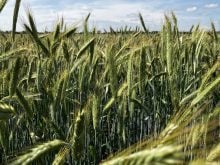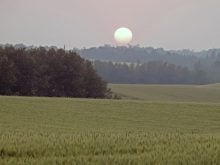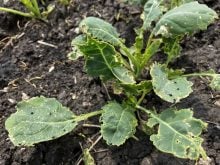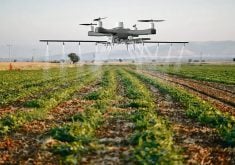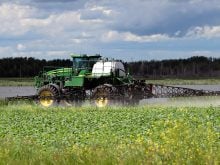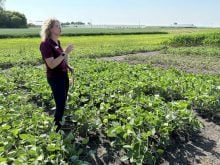WINNIPEG – In mid-August last year, people in Speers, Sask., noticed a spray plane flying over the town and nearby for three consecutive days.
The plane was applying pesticide to fields around Speers, a community of 70 people about 100 kilometres northwest of Saskatoon.
The residents didn’t think much about it because spray planes are a common sight. But a few days later, they noticed something strange in their gardens.
The plants had blotches on the leaves and some vegetables had pockmarks.
“It almost looked like acid was dropped on the cucumbers, the beans. There was very noticeably something wrong,” said one Speers resident.
A few days later, it became obvious that poplar trees in town were also damaged.
“(They) all turned brown on the south side of the trees,” said another resident. “The north side remain green, which was quite conspicuous.”
Residents began to suspect the damage was connected to the spray plane. Eventually, 18 people in Speers and area submitted pesticide incident reports to the province.
“I think there were more people affected than actually filed a report,” one resident said.
In Saskatchewan, the agriculture ministry is responsible for investigating complaints of pesticide drift, so a forensic agrologist from that department travelled to Speers last fall to gather information and collect samples of the damaged plants.
Igor de Albuquerque, the forensic agrologist, said 18 complaints about pesticide damage from a town of 70 people is unusual. In an interview with The Western Producer, he said the investigation in Speers is now closed.
“We already took enforcement action against the applicators,” he said.
However, De Albuquerque couldn’t speak about the results of his investigation and what happened in Speers, including the name of the spray plane company, why the enforcement action was taken, what chemicals were involved, and other details.
Since the application happened in mid-August, it’s likely the plane was applying a desiccant or glyphosate to dry crops prior to harvest. Glyphosate is not a desiccant, but many growers apply it as a pre-harvest aid and for late season weed control.
An agriculture ministry spokesperson said the province won’t make the details from Speers public because it doesn’t want to “inadvertently” release private information about the people who filed complaints.
A provincial document on pesticide licensing says the ministry has a “graduated discipline policy” for pesticide applicators.
“The ministry strategy is to promote cooperation so licensees will be encouraged (educated) to obtain compliance on their own. However, some violations will be more serious and therefore warrant more severe enforcement action such as licence suspension or cancelation.”
The consequence for the spray plane operator in the Speers incident is unclear, but cases of pesticide drift from aerial applications are potentially under-reported.
Royce Moellenbeck is in his final year of agriculture studies at the University of Saskatchewan, specializing in animal science. Last September, his mother and grandmother noticed unusual spots on their garden vegetables and plants in Englefeld, Sask.
Initially, Moellenbeck dismissed the spots.
“Then we were looking at the trees and they all had the same spots. We put it on Facebook. And our neighbours had also (noticed) it,” said Moellenbeck, whose family operates a mixed farm.
The Moellenbecks traced the damage to a spray plane seen over a field of canola just south of the town in September.
“My dad was outside the day they were spraying, and the air was a little heavier that day,” said Moellenbeck, who was writing his final exams in early April.
In addition to the gardens and trees in Englefeld, the drift may have damaged one of the Moellenbeck’s pastures near the desiccated canola field. About 30 acres of pasture turned brown.
The Moellenbecks didn’t file an official complaint with the provincial government. Instead, they spoke to the canola grower who hired the plane.
“We handled it in an off-the-books way, hoping it doesn’t happen again,” said Moellenbeck. “I’m from a grain and livestock background, so I’m not against spraying by any means…. No one is trying to do it on purpose. But when it happens, it really hurts people around it.”
The number of desiccant drift cases in Saskatchewan is unknown because many residents and landowners are thought to deal with it on their own. Like the Moellenbecks, they don’t file a report with the province.
“The vast majority of drift incidents is settled by the parties involved and there is no reporting required, I believe. The provincial government might hear about 10-20 percent of them, I’m guessing,” said Tom Wolf, a well-known expert in sprayers, spray drift and pesticide application, who runs Agrimetrix Research & Training in Saskatoon.
Pesticide incident reports don’t contain sufficient information to determine whether incidents of drift from aerial application are rising, falling or static.
“We don’t have enough data for me giving you (such) a statement,” de Albuquerque said.
Spraying a desiccant or pre-harvest aid from a plane can be done safely, but the risk of drift is higher than with ground applications, said Wolf.

“It is well known … that aerial application has a greater risk of spray drift than ground application, all other things being equal. Aerial applicators still manage to avoid drift by being more careful … by avoiding times when the wind heads towards sensitive areas, or when there is a risk of a temperature inversion.”
De Albuquerque agreed it’s possible to safely apply desiccants and glyphosate from a plane.
“We have our training process in Saskatchewan … you have to take a training course with Sask Polytech and you have to be licensed with us,” he said. “As long as you follow the label and follow the (restrictions), aerial application of herbicides is safe. … But, of course, mistakes happen.”
Aerial applicators are now spraying fewer herbicides because of drift risk. Applying fungicides by plane has replaced that business, Wolf added.
“(There are) relatively few herbicides with aerial labels now. The registrants don’t want the trouble with drift complaints.”
Compared to 10 years ago, straight-cutting canola is a common practice in Western Canada so desiccation might also be more common and some of it is done by plane.
“Whereas desiccation was primarily used in pulse crops, it is now more widely used in canola, creating time pressure to get the job done,” Wolf said, adding that aerial applicators take ongoing training and understand the technical risks of drift.
“(But) as desiccation grows, it’s possible that pilots are needing to once again be more careful than they’re used to.”
The Western Producer contacted the Saskatchewan Aerial Applicators Association and the Canadian Aerial Applicators Association for this story. They declined to comment.




